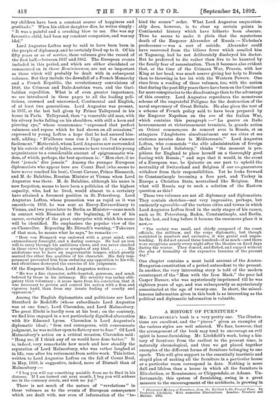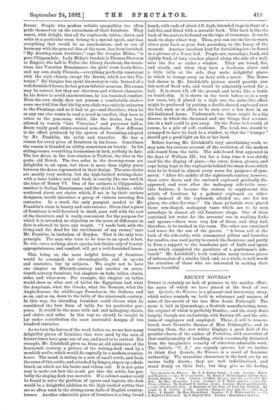A HISTORY OF FURNITURE.*
MB. LITCHFIELD's book is a very pretty one. The illustra- tions are excellent, and the " pieces " given as examples of the various styles are well selected. We fear, however, that the arrangement of the book may tend to encourage an evil spirit in house-furnishing. Mr. Litchfield's work, being a his- tory of furniture from the earliest to the present time, is naturally chronological, and thus we get placed together examples of the different forms of furniture belonging to one epoch. This will give support to the essentially inartistic and stupid plan of making all the furniture in a particular house or a particular room correspond in date. Nothing is more dull and lifeless than a house in which all the furniture is Elizabethan, or Renaissance, or Chippendale, or Adams. Un- fortunately, this system of furnishing, owing in a great measure to the encouragement of the architects, is growing in • Illustrated Hi4ory of Furniture, from the Earliest to the Present Time. By Frederick Litchfield. With numerous Illustrations. London: Truelove and Shirley. 1892.
favour. People who profess artistic sympathies too often pride themselves on the correctness of their furniture. They assert, with delight, that all the cupboards, tables, chairs, and sofas in a particular room belong to a special epoch, and that everything that would be an anachronism, and so out of harmony with the general idea of the room, has been banished. " My drawing-room furniture," says Sir Gorgias Midas, " is pure Chippendale. Lady Midas's boudoir is Thomas Sheraton or Empire, the hall is Tudor, the library Jacobean, the music- room late Venetian Renaissance, the girls' room Louis Seize, and my own study Flemish,—everything perfectly consistent with the style chosen, except the drains, which are late Vic- torian." Sir Gorgias has spent his money in vain. Instead of a well-furnished house, he has got an inferior museum. His rooms may be correct, but they are cheerless and without character. In his desire to avoid anachronisms, he has banished comfort. Even his own study does not possess a comfortable chair— some one told him that his big arm-chair was entirely.unknown to the Flemings, and so it had to go—and therefore, when he or any one else wants to read a novel in comfort, they have to retire to the gun-room, which, like the drains, has been allowed to remain "late Victorian," and possesses half-a- dozen really good chintz-covered arm-chairs. How different is the effect produced by the system of furnishing adopted by Mr. Franklin, the artist and traveller. He has a reason for every piece of furniture in his house. Sometimes the reason is founded on utility, sometimes on beauty. In his sitting-rooms, everything harmonises in look, nothing in date. The low divan in the bow-window is Turkish, the tiles in the grate, old Dutch. The two sofas in the drawing-room are delightful to sit upon, but there is more than eighty years between the dates represented in their design. The arm-chairs are mostly very modern, but the high-backed writing-chair, with a loose leather seat and back, is exactly like one used in the time of Henry VI. One of the cabinets is Chippendale, another is Italian Renaissance, and the third is Indian ; while scattered about are chairs which, if sat in by their various designers, would introduce a group of visitors covering five centuries. In a word, the only passport needed to Mr. Franklin's room is beauty and convenience. Given that apiece of furniture is well-favoured in itself, goes well with the rest of the furniture, and is really convenient for the purpose for which it is intended, no objection on the score of difference in date is allowed to have any weight. " I trade both with the living and the dead for the enrichment of my rooms," says Mr. Franklin, in imitation of Dryden. That is the only true principle. The man who tries to be true to an epoch is lost. He who cares nothing about epochs, but thinks only of beauty, appropriateness, and comfort, will get a well-furnished house.
This being so, the most helpful history of furniture would be arranged, not chronologically, and in epochs and centuries, but by subjects. We ought not to have one chapter on fifteenth-century and another on seven- teenth-century furniture, but chapters on beds, tables, chairs, sofas, and what-pots. For example, the chapter on tables would show us what sort of tables the Egyptians had, what the Assyrians, what the Greeks, what the Romans, what the Anglo-Saxons, the middle-age Frenchmen, the Italians, and so on, and so on, down to the table of the nineteenth century. In this way, the intending furnisher could choose what he considered the best form of table for his particular pur- poses. It would be the same with oak and mahogany chests, and chairs and sofas. In this way we should be taught to lay under contribution the most successful designs of two hundred centuries.
As we turn the leaves of the work before us, we see how many delightful pieces of furniture that were used by the men of former times have gone out of use, and need to be revived. For example, Mr. Litchfield gives us, from an old miniature of the fourteenth century, a picture of the writing-desk used by a monkish scribe, which would do capitally in a modern country- house. The monk is sitting in a sort of small settle, and from the arms of this settle, and attached by hinges, slopes up a desk- board, on which are his books and vellum roll. It is not quite easy to make out how the monk got into the settle, but pro- bably the sloping desk was movable. If a cabinet-maker could be found to solve the problem of egress and ingress, the desk would be a delightful addition to the high-backed settles that are so often used in the sitting-room halls of English country- houses. Another admirable piece of furniture is a long, broad bench, with ends of about 4 ft. high, intended to go in front of a hall fire, and fitted with a movable back. This back is like the back of the seats to be found on the tops of tramways. It can be made to slope either way. Thus, you can use the fire to warm either your back or your feet, according to the fancy of the moment. Another excellent hint for furnishing is to be found in a picture of a Norse bed. People are, nowadays, fond, and rightly fond, of long couches placed along the side of a wall, near the fire or under a window. They are broad, fiat, and steady, and when they have a bookcase above and a little table at the side, they make delightful places in which to lounge away an hour with a novel. The Norse bed shown in Mr. Litchfield's picture would provide just this sort of fixed sofa, and would be admirably suited for a hall. It is about 4 ft. off the ground, and looks like a berth on board ship. It is shown in the work before us in a very low room, but, if placed in a high one, the niche-like effect might be produced by putting a double-doored cupboard over the bed, such as is often to be seen over a low door in an old-fashioned house. Underneath, too, there might be a big drawer, in which the thousand and one things that accumu- late in a hall could be put away. On the Norse bed would, of course, be a pile of soft cushions. The head, too, should be arranged to have its back to a window, so that the " lounger " should get a good light on his or her book.
Before leaving Mr. Litchfield's very entertaining work, we may note his curious account of the evolution of the modern side-board from the table. The side-board first appeared in the days of William III.; but for a long time it was chiefly used for the display of plate,—the extra dishes, glasses, and cups being kept in the cupboards behind the sham doors which were to be found in almost every room for purposes of sym- metry. "After the middle of the eighteenth century, however, these extra doors and the enclosed cupboard gradually dis- appeared, and soon after the mahogany side-table came into fashion ; it became the custom to supplement this article of furniture by a pedestal cupboard on either side (instead of the cupboards alluded to), one for hot plates, the other for wine." On these pedestals were placed those urn-shaped, mahogany vases which are to be seen nowadays in almost all old furniture shops. One of these contained hot water for the servants' use in washing forks and spoons,—there were very few of these, and they had, therefore, to be washed in the room. The other urn contained iced water for the use of the guests. " A brass rail at the back of the side-table, with ornamental pillars and branches for candles, was used partly to enrich the furniture, and partly to form a support to the handsome pair of knife and spoon cases which completed the garniture of a gentleman's side- board." Mr. Litchfield's book contains many curious pieces of information of a similar kind, and, as a whole, is well worth the attention of those who are interested in making their houses beautiful.



































 Previous page
Previous page